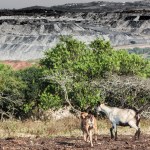TOXIC INC
Harties vs the hyacinth (Part 2) – Rampant growth of the weed is choking everything in its path, including businesses

Businesses in and around the Hartbeespoort Dam say the lack of management of hyacinth means companies are unable to operate businesses that are dependent on the dam, yet proposals to clean up the dam are being rejected.
At any given point, large areas of the Hartebeespoort Dam are covered with invasive water hyacinth, leaving many businesses relying on the dam for their livelihood frustrated. Not Matome Malatjie.
Malatjie saw only an opportunity. Concern about the hyacinth in the dam pushed the CEO of Hya Matla Organics to find what he calls a sustainable solution to the poorly managed hyacinth covering the dam, while exploring a viable business venture.
Through his company, he began collecting the hyacinth and turning it into organic fertiliser.
“So we looked into fertiliser because we are a drought-stricken country and the product (fertiliser) is 90% water. It retains much moisture, and when placed on land it’s beneficial. We don’t have enough fertiliser in the country as there’s a shortage; most of the fertiliser is coming from overseas. We were looking to solve an environmental issue while at the same time being sustainable,” Malatjie told Daily Maverick.
His efforts to remain sustainable, however, came to a halt when the dam was illegally sprayed with a herbicide by an unknown individual, and he could no longer harvest the weed that keeps his business, which employs 35 people (including locals), going.
Malatjie has since moved his operations to Bospoort and Brakpan dams in North West and Gauteng respectively.
“For us, when the dam is full of hyacinth, it’s a celebration because that’s what we want for our business. But on the flip side, for those that are in recreation – tourism is stifled a bit, the fisherman can’t do their fishing … so it affects them. So you need a balance; which we don’t have now. For my survival I need hyacinth. So if we could have 10–20% of the dam filled with hyacinth, then I would continue with my business and they could have clear areas where they can cruise etc.”
The dam (hyacinth) coverage
When Daily Maverick was reporting this story, 60% of the dam was covered by hyacinth.
According to Albi Modise, now the former chief communications officer of the Department of Forestry, Fisheries and the Environment (DFFE), this was “due to the absence of biocontrol agents, due to human interventions and the recent rains that pushed the water hyacinth down from the top of the catchment”.
Modise said that in addition to the hyacinth, there were other macrophytes (aquatic plants), such as salvinia, a water fern. Daily Maverick previously reported that the uncontrolled hyacinth and hyper-nutritious waters of the dam were the perfect breeding ground for bacteria that react with purifying agents at waterworks facilities potentially creating a liver carcinogen.
Read in Daily Maverick: Harties vs the hyacinth (Part 1) – The toxic dangers lurking under cover of an invasive weed
Water hyacinth thrives in nutrient-rich water, and Hartebeespoort Dam is nutrient dense thanks to the inflow from 10 different water treatment works. Regular flooding upstream adds to this already teeming soup.
“December (2022) was OK. January came, and we had those floods and it just brought down all the sewage from Johannesburg. All the sewage works were off because of load shedding. So they just pumped all the sewage into Jukskei River and the hyacinth just boomed; it was a month and the dam was covered.” Dion Mostert of the Harties Boat Company told Daily Maverick.
Read in Daily Maverick: Thousands hit by floods across SA, more weekend downpours predicted
The Harties Boat Company, much like the town of Hartbeespoort, depends on tourism to keep afloat. However, with the hyacinth forming a layer on the dam and becoming what Mostert says as one of the most destructive bouts of hyacinth yet, business slowed and millions was lost.
“In this period, we’ve probably lost about R2-million in turnover,” Mostert said, adding that a lot of garbage and trees came down the rivers, getting trapped underneath the hyacinth.
So when you drive a boat, you can’t see all of that. And those trees get stuck in your propellers, which then causes the boats to break down. I’ve replaced gearboxes and 20 propellers in the last two months,” Mostert said.
Mostert had to cancel boat cruises. In terms of a threat to his business, he compared the hyacinth to the Covid-19 pandemic. Mostert kept on his staff during the pandemic and he’s trying to do the same for his 25 permanent employees through what he considers a travesty to the tourism industry in the town.

Jonathan Raulo of AI Powercraft is seen testing a jet-ski that he repaired at the Harties Dam. The businessman has almost given up on testing his repairs at the dam due to the uncontrolled hyacinth. Photo: Julia Evans
Rejected proposals
Like Malatjie, Mostert also saw an opportunity to rid the dam of hyacinth and tocreate employment.
Several months ago, Mostert proposed to the Department of Water and Sanitation (DWS) that he be granted permission to manually remove the hyacinth and employ about 500 people to help him. He says he is yet to receive a response.
Some individuals and affected businesses such as Harties Boat Club considered removing the hyacinth in a section of the dam using herbicide spray. This request was rejected by DFFE, on the grounds that specific procedures had to be carried out in relation to risk assessments. The DWS said it was against their policy.
“The system currently is in a semi-stable state with the biocontrol populations severely impacting the water hyacinth, so I do not recommend a spray at the moment as the impacts of the biocontrol on the system first needs to be assessed,” a DFFE official said in an emailed response, seen by Daily Maverick, to a request to spray herbicides.
The official said that the November rains also added an influx of nutrients that contributed to the growth of the hyacinth. She continued that there was delayed action from biocontrol to exceptional growth of the plant.
Daily Maverick previously reported that the Rhodes Centre for Biological Control maintained that the overgrowth was also owing to a lack of a supervisor at the dam site to monitor the biocontrol of the bugs eating away at the hyacinth.
For Mike King, a retiree who consults for the local Heures plant nursery, water quality and lack of bacteria control have been costly concerns for the business. The nursery is home to domestic plants and trees, but has also grown to house more specialised plants such as citrus.
King told Daily Maverick that the presence of blue-green algae in the dam water has become a problem for both the domestic plants and citrus as some of them cannot withstand the chlorine used to clear out the algae.
“We have to revert to borehole water,” King said. “Our plants get root sickness (when they use dam water with blue-green algae). They pick up root diseases so we get a lot of root rot. We also get phytophthora (a water mould causing plant disease).
“Another sickness is called pythium (a fungus that causes rot from the root tip); these are waterborne diseases. We have to then chlorinate to kill those pathogens. And when we chlorinate, some of our plants can’t tolerate chlorine at all, and so our plants die. That’s why we have to revert to using borehole water, which we have a short supply of,” King said.
Hyacinth growth has also been a headache for Jonathan Raulo of AI Powercraft, who repairs and sells jet skis. Raulo told Daily Maverick he has been testing repaired jet skis at the dam since 2012, but hasn’t been able to carry out his work since February 2023.
“It’s really killing our business because we can’t get paid until final testing is done. Normally we do all the work, bring the ski out for testing and send a video and then they arrange payment … So it’s been affecting cash flow quite badly. I’ve engaged with the owner to try and clean it up because the people trying to [clean the dam] are operating at too small of a scale and operating with the wrong equipment,” Raulo said.
First brought in for aquatic ornamental reasons, hyacinth is now growing rapidly across South African water bodies, particularly at Harties, choking almost anything in its way; including businesses.
Biocontrol measures aren’t operating at the pace that businesses need them to, crippling companies who create local employment opportunities. Hyacinth has been a problem for decades. Every year of it not being addressed means another year of a layer of water ornamentals and declining businesses. DM




















 Become an Insider
Become an Insider
Comments - Please login in order to comment.